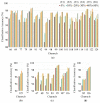An Accurate and Robust Method for Spike Sorting Based on Convolutional Neural Networks
- PMID: 33187098
- PMCID: PMC7696441
- DOI: 10.3390/brainsci10110835
An Accurate and Robust Method for Spike Sorting Based on Convolutional Neural Networks
Abstract
In the fields of neuroscience and biomedical signal processing, spike sorting is a crucial step to extract the information of single neurons from extracellular recordings. In this paper, we propose a novel deep learning approach based on one-dimensional convolutional neural networks (1D-CNNs) to implement accurate and robust spike sorting. The results of the simulated data demonstrated that the clustering accuracy in most datasets was greater than 99%, despite the multiple levels of noise and various degrees of overlapped spikes. Moreover, the proposed method performed significantly better than the state-of-the-art method named "WMsorting" and a deep-learning-based multilayer perceptron (MLP) model. In addition, the experimental data recorded from the primary visual cortex of a macaque monkey were used to evaluate the proposed method in a practical application. It was shown that the method could successfully isolate most spikes of different neurons (ranging from two to five) by training the 1D-CNN model with a small number of manually labeled spikes. Considering the above, the deep learning method proposed in this paper is of great advantage for spike sorting with high accuracy and strong robustness. It lays the foundation for application in more challenging works, such as distinguishing overlapped spikes and the simultaneous sorting of multichannel recordings.
Keywords: convolutional neural network; deep learning; extracellular recording; spike sorting.
Conflict of interest statement
The authors declare no conflict of interest.
Figures









Similar articles
-
Classification of overlapping spikes using convolutional neural networks and long short term memory.Comput Biol Med. 2022 Sep;148:105888. doi: 10.1016/j.compbiomed.2022.105888. Epub 2022 Jul 19. Comput Biol Med. 2022. PMID: 35872414
-
Deep learning-based spike sorting: a survey.J Neural Eng. 2024 Nov 14;21(6). doi: 10.1088/1741-2552/ad8b6c. J Neural Eng. 2024. PMID: 39454590 Review.
-
Deep-learned spike representations and sorting via an ensemble of auto-encoders.Neural Netw. 2021 Feb;134:131-142. doi: 10.1016/j.neunet.2020.11.009. Epub 2020 Nov 27. Neural Netw. 2021. PMID: 33307279
-
DualSort: online spike sorting with a running neural network.J Neural Eng. 2023 Oct 5;20(5). doi: 10.1088/1741-2552/acfb3a. J Neural Eng. 2023. PMID: 37795548
-
From End to End: Gaining, Sorting, and Employing High-Density Neural Single Unit Recordings.Front Neuroinform. 2022 Jun 13;16:851024. doi: 10.3389/fninf.2022.851024. eCollection 2022. Front Neuroinform. 2022. PMID: 35769832 Free PMC article. Review.
Cited by
-
Anti-Disturbance of Scale-Free Spiking Neural Network against Impulse Noise.Brain Sci. 2023 May 22;13(5):837. doi: 10.3390/brainsci13050837. Brain Sci. 2023. PMID: 37239309 Free PMC article.
-
PseudoSorter: A self-supervised spike sorting approach applied to reveal Tau-induced reductions in neuronal activity.Sci Adv. 2025 Mar 14;11(11):eadr4155. doi: 10.1126/sciadv.adr4155. Epub 2025 Mar 14. Sci Adv. 2025. PMID: 40085717 Free PMC article.
-
Advancing Spike Sorting Through Gradient-Based Preprocessing and Nonlinear Reduction With Agglomerative Clustering.Brain Behav. 2025 Jul;15(7):e70650. doi: 10.1002/brb3.70650. Brain Behav. 2025. PMID: 40607611 Free PMC article.
-
Wireless closed-loop deep brain stimulation using microelectrode array probes.J Zhejiang Univ Sci B. 2024 Feb 12;25(10):803-823. doi: 10.1631/jzus.B2300400. J Zhejiang Univ Sci B. 2024. PMID: 39420519 Free PMC article. Review.
-
Multi-material Electrohydrodynamic Printing of Bioelectronics with Sub-Microscale 3D Gold Pillars for In Vitro Extra- and Intra-Cellular Electrophysiological Recordings.Adv Sci (Weinh). 2025 Mar;12(9):e2407969. doi: 10.1002/advs.202407969. Epub 2025 Jan 10. Adv Sci (Weinh). 2025. PMID: 39792774 Free PMC article.
References
-
- Arel I., Rose D.C., Karnowski T.P. Deep machine learning-a new frontier in artificial intelligence research. IEEE Comput. Intell. Mag. 2010;5:13–18. doi: 10.1109/MCI.2010.938364. - DOI
Grants and funding
LinkOut - more resources
Full Text Sources

